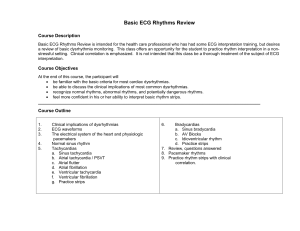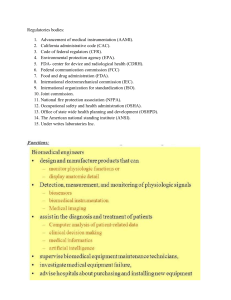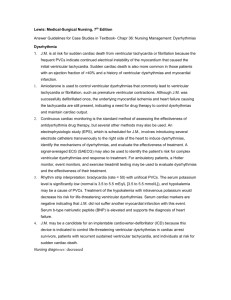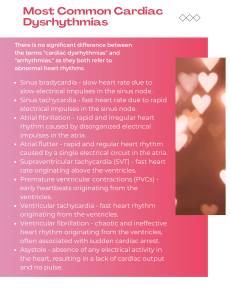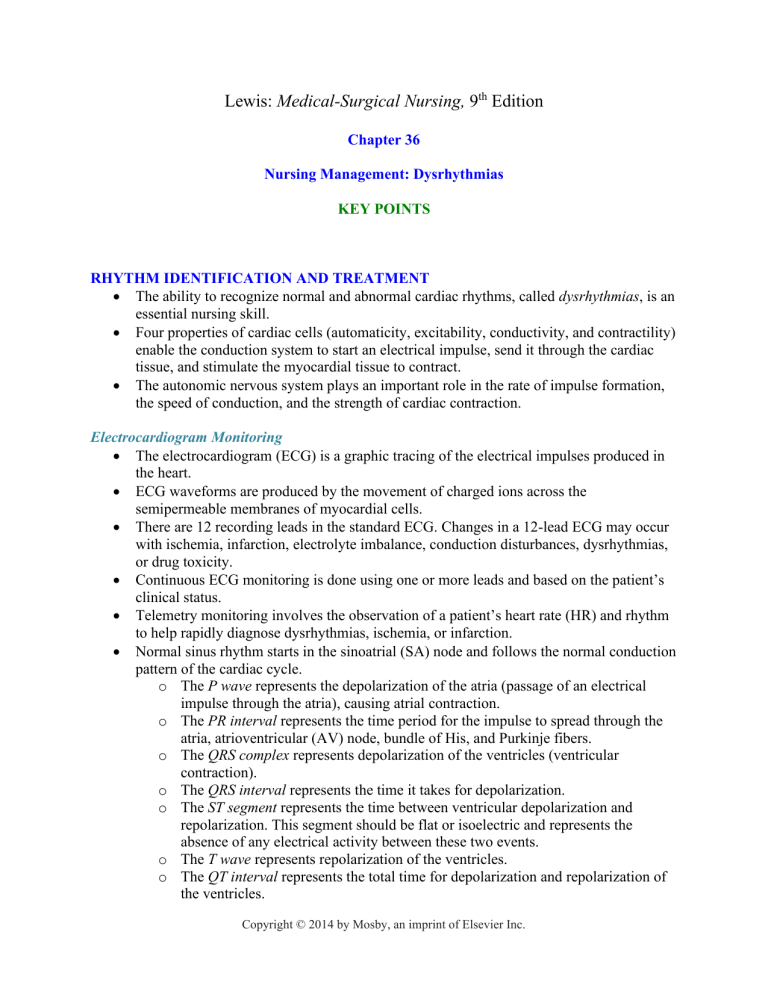
Lewis: Medical-Surgical Nursing, 9th Edition Chapter 36 Nursing Management: Dysrhythmias KEY POINTS RHYTHM IDENTIFICATION AND TREATMENT • The ability to recognize normal and abnormal cardiac rhythms, called dysrhythmias, is an essential nursing skill. • Four properties of cardiac cells (automaticity, excitability, conductivity, and contractility) enable the conduction system to start an electrical impulse, send it through the cardiac tissue, and stimulate the myocardial tissue to contract. • The autonomic nervous system plays an important role in the rate of impulse formation, the speed of conduction, and the strength of cardiac contraction. Electrocardiogram Monitoring • The electrocardiogram (ECG) is a graphic tracing of the electrical impulses produced in the heart. • ECG waveforms are produced by the movement of charged ions across the semipermeable membranes of myocardial cells. • There are 12 recording leads in the standard ECG. Changes in a 12-lead ECG may occur with ischemia, infarction, electrolyte imbalance, conduction disturbances, dysrhythmias, or drug toxicity. • Continuous ECG monitoring is done using one or more leads and based on the patient’s clinical status. • Telemetry monitoring involves the observation of a patient’s heart rate (HR) and rhythm to help rapidly diagnose dysrhythmias, ischemia, or infarction. • Normal sinus rhythm starts in the sinoatrial (SA) node and follows the normal conduction pattern of the cardiac cycle. o The P wave represents the depolarization of the atria (passage of an electrical impulse through the atria), causing atrial contraction. o The PR interval represents the time period for the impulse to spread through the atria, atrioventricular (AV) node, bundle of His, and Purkinje fibers. o The QRS complex represents depolarization of the ventricles (ventricular contraction). o The QRS interval represents the time it takes for depolarization. o The ST segment represents the time between ventricular depolarization and repolarization. This segment should be flat or isoelectric and represents the absence of any electrical activity between these two events. o The T wave represents repolarization of the ventricles. o The QT interval represents the total time for depolarization and repolarization of the ventricles. Copyright © 2014 by Mosby, an imprint of Elsevier Inc. Key Points • 36-2 Dysrhythmias result from disorders of impulse formation, conduction of impulses, or both. Evaluation of Dysrhythmias • Dysrhythmias result from various abnormalities and disease states, and the cause of a dysrhythmia influences the treatment. • Noninvasive diagnostic tests used to evaluate cardiac dysrhythmias and the effectiveness of antidysrhythmia drug therapy include Holter monitoring, event monitoring (or loop recorder), exercise treadmill testing, and signal-averaged ECG. • An electrophysiologic study (EPS) identifies different mechanisms of tachydysrhythmias, heart blocks, bradydysrhythmias, and causes of syncope. Types of Dysrhythmias • Sinus bradycardia has a normal sinus rhythm, but the SA node fires at a rate less than 60 beats per minute. It may be a normal clinical condition. Treatment is only indicated in those with symptoms. • Sinus tachycardia has a normal sinus rhythm, but the SA node fires at a rate 101 to 200 beats per minute because of vagal inhibition or sympathetic stimulation. o It is associated with stressors such as exercise, fever, pain, hypotension, hypovolemia, anemia, hypoxia, hypoglycemia, myocardial ischemia, heart failure (HF), hyperthyroidism, anxiety, and fear. It can also be an effect of certain drugs. o Treatment is based on the underlying cause. • Premature atrial contraction (PAC) is a contraction originating from an ectopic focus in the atrium in a location other than the sinus node. PACs come earlier than the next expected sinus beat. In healthy persons, isolated PACs are not significant. In persons with heart disease, frequent PACs may warn of or initiate more serious dysrhythmias. • Paroxysmal supraventricular tachycardia (PSVT) is a dysrhythmia originating in an ectopic focus anywhere above the bifurcation of the bundle of His. The rate is 150 to 220 beats per minute. o Prolonged PSVT with HR greater than 180 beats per minute may decrease cardiac output (CO), resulting in hypotension, dyspnea, and angina. o Treatments for PSVT include vagal stimulation and IV adenosine. • Atrial flutter is an atrial tachydysrhythmia identified by recurring, regular, sawtoothshaped flutter waves that originate from a single ectopic focus in the right atrium. o High ventricular rates (over 100 per minute) and the loss of the atrial “kick” (atrial contraction reflected by a sinus P wave) can decrease CO and cause serious consequences such as chest pain and HF. o Patients with atrial flutter are at increased risk of stroke. o Radiofrequency catheter ablation is the treatment of choice. • Atrial fibrillation is characterized by a total disorganization of atrial electrical activity caused by multiple ectopic foci resulting in loss of effective atrial contraction. o Atrial fibrillation usually occurs in the patient with underlying heart disease, such as coronary artery disease (CAD), rheumatic heart disease, and cardiomyopathy. o Atrial fibrillation often results in a decrease in CO and poses an increased risk of stroke because of clot formation, necessitating anticoagulation therapy. o For patients with drug-refractory atrial fibrillation or who do not respond to Copyright © 2014 by Mosby, an imprint of Elsevier Inc. Key Points • • • • • • • 36-3 electrical conversion, radiofrequency catheter ablation and the Maze procedure are options. Junctional dysrhythmias refer to dysrhythmias that originate in the area of the AV node, in which the AV node becomes the pacemaker of the heart. Junctional dysrhythmias include junctional premature beats, junctional escape rhythm, accelerated junctional rhythm, and junctional tachycardia. These dysrhythmias are treated according to the type, patient’s tolerance of the rhythm, and patient’s clinical condition. In first-degree AV block, every impulse is conducted to the ventricles, but the duration of AV conduction is prolonged. First-degree AV block is usually not serious but can be a precursor of higher degrees of AV block. Patients with first-degree AV block are asymptomatic. There is no treatment. In second-degree AV block, type I (Mobitz I or Wenckebach heart block), there is a gradual lengthening of the PR interval until an atrial impulse is nonconducted and a QRS complex is blocked (missing). o Type I AV block is usually a result of myocardial ischemia or inferior MI. It is almost always transient and is usually well tolerated. However, it may be a warning signal of a more serious AV conduction disturbance. o If the patient is symptomatic, atropine is used to increase HR, or a temporary pacemaker may be needed. Second-degree AV block, type II (Mobitz II heart block), involves a P wave that is nonconducted without progressive antecedent PR lengthening. This almost always occurs when a block in one of the bundle branches is present (e.g., anterior MI). o Type II AV block often progresses to third-degree AV block and is associated with a poor prognosis. o Treatment before the insertion of a permanent pacemaker may be necessary if the patient becomes symptomatic and involves the use of a temporary transvenous or transcutaneous pacemaker. In third-degree AV block, or complete heart block, no impulses from the atria are conducted to the ventricles. o It almost always results in reduced CO with subsequent ischemia, HF, and shock. o For symptomatic patients, a transcutaneous pacemaker is used until a temporary transvenous pacemaker can be inserted followed by a permanent pacemaker. Premature ventricular contraction (PVC) is the premature occurrence of a QRS complex, which is wide and distorted in shape compared with a QRS complex initiated from the normal conduction pathway. o PVCs are usually a benign finding in the patient with a healthy heart. In heart disease, depending on frequency, PVCs may reduce the CO and precipitate angina and HF. o Treatment is often based on the cause of the PVCs (e.g., oxygen therapy for hypoxia, electrolyte replacement). Drugs that can be considered include adrenergic blockers, procainamide, amiodarone, or lidocaine. Ventricular tachycardia (VT) is a run of three or more PVCs. It occurs when an ectopic focus or foci fire repetitively and the ventricle takes control as the pacemaker. o VT is a life-threatening dysrhythmia because of decreased CO and the possibility of deterioration to ventricular fibrillation, which is a lethal dysrhythmia. o VT is associated with myocardial infarction (MI), CAD, significant electrolyte Copyright © 2014 by Mosby, an imprint of Elsevier Inc. Key Points • • • • 36-4 imbalances, cardiomyopathy, mitral valve prolapse, long QT syndrome, digitalis toxicity, and central nervous system disorders. o VT can be stable (patient has a pulse) or unstable (patient is pulseless). o Precipitating causes must be identified and treated (e.g., electrolyte imbalances, ischemia). o Treatment involves drug therapy and/or synchronized cardioversion for a stable patient and rapid defibrillation for an unstable patient. Ventricular fibrillation (VF) is characterized on ECG by irregular undulations of varying shapes and amplitude. VF results in an unresponsive, pulseless, and apneic state. If not rapidly treated, the patient will die. Treatment consists of immediate initiation of CPR and advanced cardiac life support (ACLS) measures with the use of defibrillation and definitive drug therapy. Asystole represents the total absence of ventricular electrical activity with the patient being unresponsive, pulseless, and apneic. Asystole requires immediate treatment consisting of CPR with initiation of ACLS measures. Pulseless electrical activity (PEA) describes a situation in which electrical activity is observed on the ECG, but there is no mechanical activity of the ventricles and the patient has no pulse. PEA requires immediate treatment consisting of CPR with initiation of ACLS measures. Sudden cardiac death (SCD) refers to death from a cardiac cause. The majority of SCDs result from ventricular dysrhythmias, specifically ventricular tachycardia or fibrillation. TREATMENT OF DYSRHYTHMIAS • Defibrillation, the passage of a DC electrical shock through the heart to depolarize the cells of the myocardium, is the most effective method of terminating VF and pulseless VT. o Manual defibrillators require health care providers to interpret cardiac rhythms, determine the need for a shock, and deliver a shock. o Automatic external defibrillators have rhythm detection capability and the ability to advise the operator to deliver a shock using hands-free defibrillator pads. • Synchronized cardioversion using a defibrillator is the therapy of choice for the patient with ventricular (e.g., VT with a pulse) or supraventricular tachydysrhythmias. • The implantable cardioverter defibrillator (ICD) is used for patients who have survived SCD, have spontaneous sustained VT, have syncope with inducible ventricular tachycardia/fibrillation during EPS, and are at high risk for future life-threatening dysrhythmias. o The ICD sensing system monitors the HR and rhythm and identifies VT and VF. o ICD delivers a defibrillator shock or acts as a pacemaker as needed. o Education of the patient and caregiver is of extreme importance. • Radiofrequency catheter ablation therapy is used to “burn” or ablate accessory pathways or ectopic sites in the atria, AV node, and ventricles. o Catheter ablation is the nonpharmacologic treatment of choice for atrial dysrhythmias resulting in rapid ventricular rates and AV nodal reentrant tachycardia refractory to drug therapy. o Care of the patient following ablation therapy is similar to that of a patient undergoing cardiac catheterization. Copyright © 2014 by Mosby, an imprint of Elsevier Inc. Key Points 36-5 Pacemakers • The artificial cardiac pacemaker is an electronic device used to pace the heart when the normal conduction pathway is damaged or diseased. • Pacemakers provide antibradycardia, antitachycardia, and overdrive pacing. • A permanent pacemaker is implanted totally within the body. • A specialized type of cardiac pacing is used for the management of HF. o Cardiac resynchronization therapy (CRT) is a pacing technique that resynchronizes the cardiac cycle by pacing both ventricles, thus promoting improvement in ventricular function. o Devices often combine CRT with an ICD for maximum therapy. o A temporary pacemaker is one that has the power source outside the body. There are three types of temporary pacemakers: transvenous, epicardial, and transcutaneous pacemakers. • Patients with temporary or permanent pacemakers will be ECG monitored to evaluate the status of the pacemaker. • Complications of invasive temporary (i.e., transvenous) or permanent pacemaker insertion include infection and hematoma formation at the site of insertion of the pacemaker power source or leads, pneumothorax, failure to sense or capture with possible symptomatic bradycardia, perforation of the atrial or ventricular septum by the pacing lead, and appearance of “end-of-life” battery parameters on testing the pacemaker. ECG CHANGES ASSOCIATED WITH ACUTE CORONARY SYNDROME • The 12-lead ECG is the primary diagnostic tool used to evaluate patients presenting with acute coronary syndrome (ACS). • Definitive ECG changes that occur in response to ischemia, injury, or infarction of myocardial cells can be seen in the leads that face the area of involvement. o Typical changes seen in ischemia include ST-segment depression and/or T-wave inversion. o ST-segment elevation is common with myocardial injury. o ST-segment elevation and pathologic Q wave may be seen on the ECG of a patient with MI. • Patient-monitoring guidelines for patients with suspected ACS include continuous, multilead ECG and ST-segment monitoring. SYNCOPE • Syncope is a brief lapse in consciousness accompanied by a loss in postural tone (fainting). • The causes of syncope are categorized as cardiovascular or noncardiovascular: o Common cardiovascular causes of syncope include vasovagal syncope and primary cardiac dysrhythmias. o Noncardiovascular causes can include hypoglycemia, hysteria, seizure, stroke, and transient ischemic attack. • Various diagnostic tests are used to determine the cause of syncope, including echocardiography, stress testing, EPS, head-up tilt-test, Holter monitors, and event/loop recorders. Copyright © 2014 by Mosby, an imprint of Elsevier Inc.



